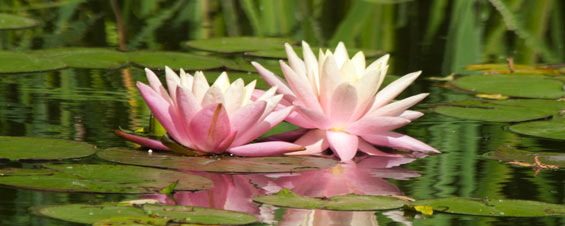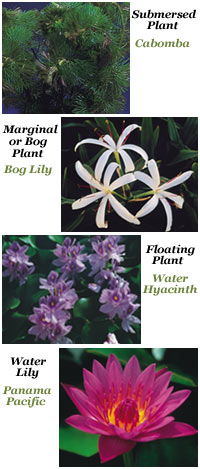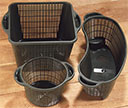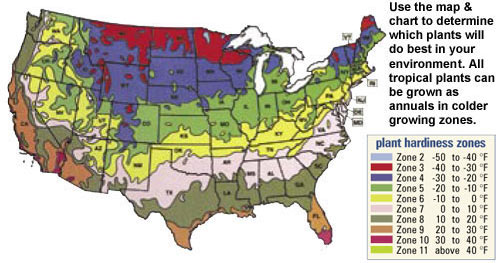
Adding pond plants is a relaxing way to beautify a water garden. However, for new water gardeners, selecting the proper pond plants can be intimidating. Do you have planting ideas for your water garden but not sure how to go about it? The following tips can help you develop your green thumb so you can enjoy a lush backyard paradise.
Making sense of planting information
The sheer diversity of different
pond plants can be overwhelming but it should not prevent you from making the right plant choice. To ensure successful water gardening, spend time getting acquainted with the specific requirements of each plant you're interested in purchasing.
Take factors such as light requirement, hardiness zone, maximum size, and growing habit into careful consideration before making your plant selection. Spend a day observing your pond and the surrounding area to determine what kind of growing conditions are present.
Pay particular attention to the amount of light your pond receives over the course of the day. You may notice some locations receive more light than others. Becoming familiar with crucial environmental factors such as light intensity and duration will help determine the ideal location for your new plants.
Plant Selection
Plants suitable for ponds are generally categorized into three basic groups:
Submerged plants are often referred to as oxygenators since they efficiently use carbon dioxide and release oxygen after photosynthesis. In addition to providing oxygen, submerged plants such as
anacharis also help improve water quality and water clarity by filtering excess nutrients from the water.
Marginal or Bog plants like
cattails and
Pickerel Rush thrive in shallow water near the perimeter of the pond. Though their roots grow underwater, the majority of the plant grows out and above the water. This diverse group of plants is perfect to help soften the hardscape and create a natural transition from pond to garden.
Floating plants are the third type of pond plants and as their name implies, float on the water surface. These plants develop extensive root systems that filter excess nutrients directly from the water and are often used as part of an algae-control regimen. Floating plants such as
Water Hyacinths also provide shade to further curb aggressive algae growth. As part of the pondscape, floating plants add visual interest as they gently drift across the pond surface, bringing motion to the pond with every breeze.
| Pond Plant Packs |

We've done the planning so you can start the planting – right out of the box!
Brighten your water garden this spring with a lush and beautiful
Plant Pack from LiveAquaria.com. We've grouped some of our favorite pond plants into guess-free kits, shipped directly to your door and ready for aquascaping your pond. Each grouping is expertly selected for its coloration, diversity, and hardiness, and grouped specific to your pond size and planting zone.
Visit
LiveAquaria.com for more pond plants. |
|
Putting it all together with a natural planting scheme
To create a natural-looking water garden, position plants in strategic locations. Incorporate the notion of foreground, midground, and background to the proposed pondscape. Place shorter plants near the edge of the pond for an unobstructed view. Then place medium height plants and then taller plants in gradual succession for a smooth visual transition. Use floating plants and shorter marginal plants as foreground plants and taller marginal plants and grasses to fill the midground. Large shrubs, located farther away from the pond, serve as the background for the entire pond. The effect is a soothing, unbroken view that gently draws the eye from the pond to the greater landscape.
|
Pond Plant Planting Instructions
Submersed Plants
Spread roots out in a plant basket and fill with planting media. (The roots serve only to anchor these plants as all nutrients come from the water and are absorbed by the leaves.) Place the basket at a depth of about 12" below the water surface. When the plant reaches the surface of the pond, lower the basket another 6".
Bog Plants
Carefully remove plant from the plastic pot in which it was shipped. Gently shake out the roots. Line a plant basket with a Blue Bonded Filter Pad cut to fit or a layer of sphagnum moss. Fill half full with planting media. Place the plant in the pot and fill remaining space with more media. Top with 1/2" gravel or pebbles from your pond to prevent media from washing away. Position the basket so that the top is just below the water surface. See Tip Box (below) for guide to selecting basket sizes.
Floating Plants
Unwrap plants and carefully spread out the roots and leaves. Float each plant on the surface of the pond. (These plants feed directly from the water through their roots so no additional fertilizer is necessary.) Occasionally, thin out floating plants so that no more than 60% of the pond's surface is covered to allow sunlight to reach fish and other vegetation in the pond.
Water Lilies
Lilies should be planted in large or extra-large baskets. Baskets are preferable as lilies do best in good water flow. Line the container with a filter pad or sphagnum moss, and fill with planting media. Place |
 |
|
root in pot with growing tips up and cover remaining half with additional soil. Press a 1" layer of sand or gravel on top to prevent soil from washing away and leaching into the water. Submerge the lily so that the leaves are at least 6" below the water surface. As the leaves grow to the surface of the pond, gradually lower the container until it is 12-18" below the water surface. |
| HOW TO CHOOSE A PLANTING CONTAINER |
 Submersed Plants: 4" wide or kidney shape and larger.
Submersed Plants: 4" wide or kidney shape and larger.
Bog Plants: 7-9" wide for small bog plants, 11-14" wide for large bog plants like Iris.
Water Lilies: 8-10" wide work for Dwarf lilies, but for regular lilies we recommend the extra-large 14" size.
Kidney shape baskets are also great for arrangements of 3-4 young bog plants.
|
Your Guide to Planning and Ordering Plants

|